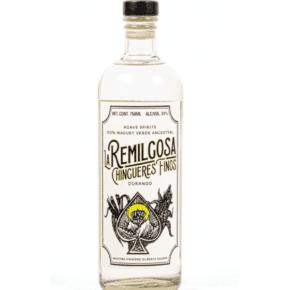Details
- Location: Alamos, Sonora
- Agave: A. pacifica
- Maestro Bacanorero: Rodrigo Bojorquez Bours
- ABV: 40%
- Tasting keywords: Menthol, grass.
- NOM: NOM-168-SCFI-2004
- Buy it today
Nose
Menthol, grassy, nopal.

Taste
Bright and light with very herbaceous flavors. They are clear and balanced expressing the steamed agave flavor with all its brightness.
Production Details
- Agave sources: Wild agave
- Roast: Underground masonry oven for five days.
- Crush: Double milled: Chopped in the first pass then crushed with a tahona.
- Fermentation: Fermented in stainless steel tanks in a controlled room at 30 degrees Centrigrade.
- Distillation: Composite pot still stainless and copper. Copper top to pull out sulphuric notes.
- Rest: Rested in 10,000 liter tanks. The distiller plays classical music at 432 hertz which is the frequency at which universe vibrates. He does this to “harmonize the molecules.”

Background Notes
Kilinga has a great back story that goes back to the distiller’s mother. When she was a child everyone around her said “Que Linda!” to her and she, in the flush of youthful vigor and verbal invention heard “Kalinga.” The word stuck and became her nickname and was so endearing that it became this Bacanora’s brand name.
Just like many of the other families that I’ve met in Bacanora world the people there tend to be ranchers and farmers. This family is no exception: Bours is a robust man who used to be a full-time rancher farmer. As with many farmers across the world now, but especially in the American Southwest and Mexican North – they share a common climactic and environmental system – he has had to deal with drought and started planting agave as a crop as an experiment. Originally he sold to other distillers but gradually experimented to the point that he got into business himself. He says that “The climate is constantly changing” so he is changing year to year to adapt to it.
Bours and his team use both tradition and innovation in their production. The process looks like most mezcal but instead of the traditional roasting pit they have created a metal cage that they lower into a cast roasting pit. Bours told me that he designed Kilinga’s equipment in order to control the type and quantity of smoke their agaves come into contact with during the roast by using mesquite cured for eight months and venting away the smoke. He also pointed to their still design as focused on keeping the bagasse from contacting the bottom of the still in order to minimize any burnt flavors.
Bours has definitely succeeded on that front because the three Kilinga expressions I tasted are very much on the spectrum with tequilas. They are bright and full of flavor with nary a hint of anything related to smoke. The silvestre is enormously expressive, the blanco is its own beast entirely, and the reposado runs off in its own direction. I haven’t had an opportunity to taste the añejo which was mostly allocated to California and New York but I am told that there are still some left with distributors.
The pricing on these bottles is beyond reasonable, especially for the quality. The silvestre retails at $35 per bottle which is amazing. The blanco is currently selling for $30 per bottle.











Leave a Comment